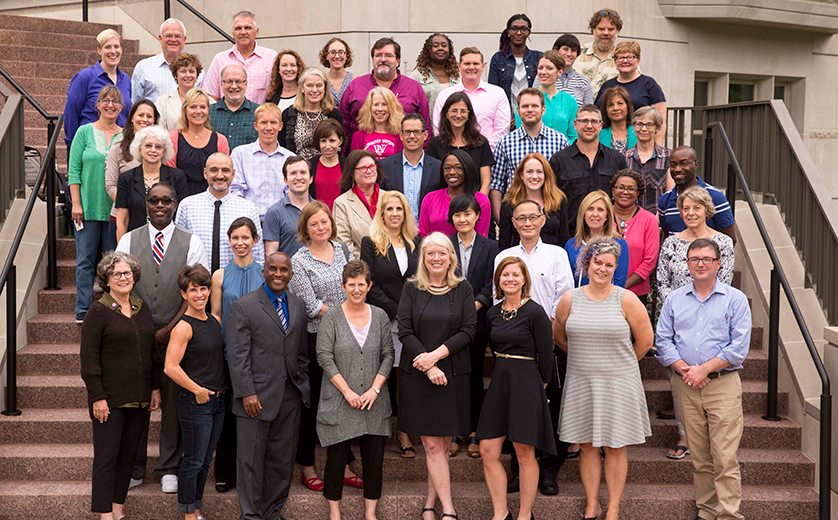WashU’s Student Life publication took an in-depth look at how the Brown School is focusing its efforts to recruit diverse faculty. Read the original article, in its entirety here.
——————————————————–
As the first school at Washington University to admit African-American students, the Brown School of Social Work has long been an institutional leader in recruiting and retaining faculty, staff, and students from underrepresented backgrounds.
The school has continued this legacy by creating a system of equity within its faculty hiring processes, reflected by women and underrepresented minorities making up a larger percentage of faculty in the Brown School than in any other Washington University school. Such commitment to creating a diverse faculty is particularly notable at a University which, has struggled to recruit and retain female and underrepresented faculty in some cases.
This dedication to equitable hiring has endured even as the school has been forced to overcome obstacles. In 2010, the departure of a number of senior faculty of color prompted remaining Brown School faculty and staff to reflect on the climate and support systems in place to support underrepresented minority faculty members.
Following this departure, the Brown School has taken several steps to ensure their faculty makeup reflects the ideals they champion. What follows is an investigation of what made these efforts so successful and a discussion of how this work can be utilized in other schools at the University.
The Brown School by the numbers
As of fall 2016, almost a quarter of Brown School tenured and tenure-track faculty members are underrepresented minorities, a number will increase when new hires are included in the most recent census, slated for completion in November. Amongst the dean’s administrative team, consisting of assistant and associate deans, 31 percent are people of color, 19 percent identify as members of the LGBTQIA* community, and 75 percent identify as women. 55 percent of tenure/tenure-track faculty members are women.
According to Dean of the Brown School Mary McKay, the recent hiring of two new faculty members—professor Fred Ssewamala and associate professor Leopoldo J. Cabassa, both of Columbia University, brings the number of underrepresented minorities to one-third of tenured and tenure-track faculty. Should the Brown School hire three additional underrepresented faculty members, that number would catapult to over 40 percent.
Ensuring equity in the recruitment process
To ensure all hiring candidates are granted an equitable hiring process, the Brown School has institutionalized diversity training. All members of the search committee are required to complete training offered by the Office for Faculty Advancement and Institutional Diversity. Facilitated by Vice Provost and law professor Adrienne Davis, these sessions focus on best practices and hiring strategies, with particular focus on uncovering implicit bias in the hiring process.
Institutionalizing equity: Faculty retention methods
Brown School administrators have taken a two-pronged approach to fostering a diverse environment, stressing that an equitable recruitment process will be in vain if the school lacks support systems to retain new faculty. In his role as associate dean for faculty and research, Sean Joe adopted an approach that prioritizes building an equitable process for Brown School faculty in every facet of their positions—research, teaching, and career advancement.
“My research experience and work in this [field] for 20 years has taught me that you have to pay attention to the social networks that are available to faculty and to ensure that, at least as an institution, in terms of our broader functioning and culture, that all faculty feel involved, engaged, and [are] given opportunities for leadership,” Joe said.
By examining data surrounding a faculty member’s workload, including the number and kind of courses being taught, the Brown School can ensure faculty of all seniority are given the same startup framework. As faculty members transition into the Brown School, their course load is reduced, allowing them to fully develop their teaching skills and the full-range of work afforded to everyone, according to Joe.
Leaders on the Danforth campus: Brown School’s vision for equity
For McKay, increasing diversity in both faculty hiring and student recruitment aligns directly with the Brown School’s broader goals.
“If we are preparing the next generation of students to be excellent leaders around social change, around dismantling racism and I absolutely need students of color in our seats enlarged. If I care about who teaches them, that they have role models and people ahead of them, I absolutely need a highly diverse faculty,” McKay said.
Within the past month, University administrators have navigated around several events affecting marginalized groups in the United States, including the Aug. 12-13 “Unite the Right” rally in Charlottesville, Va., and President Trump rescinding the Deferred Action for Childhood Arrivals (DACA) program. While McKay envisions the Brown School leading the Danforth Campus in having the most diverse faculty and student body, she believes this leadership extends to the national stage.
“Never before have I seen such a void at the highest levels around bringing us together. And tolerating and even supporting divisions by race, by class. And so we are going to need to step into that leadership space,” McKay said. “I think that the kind of events that are occurring just continue to fuel my deep commitment that our school needs to be an agent of social good, of justice, of clear communication around how our values need to translate into action in our country. I think that’s where we are and where we are going to grow to be.”
